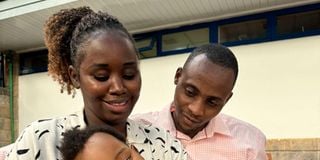World’s most expensive drug only hope for baby battling rare condition

Pauline Wanjiru and Bernand Macharia hold their baby, Jamari Kiama, who is battling Spinal Muscular Atrophy type 1. The family is racing against time to raise Sh294,000,000 for one-time drug treatment, which is required to be administered before the baby turns two.
What you need to know:
- Spinal Muscular Atrophy affects one in 6,000 to one in 10,000 births.
In retrospect, there might have been clues. When Pauline Wanjiru talks about her family tree, some fragile images flicker to life—one relative who lost their first baby before they turned two or another robbed of a chance to witness their child’s journey through elementary school.
Meanwhile, for her husband Bernard Macharia, a memory that was for long faded surfaces — a relative who mysteriously lost the ability to walk. When Bernard and Pauline met in 2016, got married in 2020 and embarked on their dream of parenthood that same year, these memories were a blur, details barely registering in their minds. Little did they know that these fleeting moments held the key to a profound truth.
From the start, theirs was a love story destined for a collision course with a rare disease.
They would later learn that they are both carriers of Spinal Muscular Atrophy (SMA1) type 1, an inherited neuromuscular disease that kills more infants worldwide than any other genetic disorder. This means that while they don’t have the disease themselves, they have copies of the mutated gene that causes SMA1.
Prof Erastus Amayo, a researcher in neurology, explains that SMA is an inherited condition affecting the nerves and muscles.
“It is caused by mutations in the survival motor neuron 1 (SMN1) gene. We all have two copies of this gene, one from each parent. In SMA, changes occur in both SMN1 copies, leading to a deficiency of a protein crucial for motor neuron function. These motor neurons are like messengers, carrying signals from the brain and spinal cord to your muscles, telling them to move,” he remarked. “Without enough of this protein, motor neurons struggle to communicate effectively. This results in muscle weakness and wasting (atrophy), often starting in the limbs and progressing in severity depending on the specific SMA type.”
SMA inheritance, experts say, is autosomal recessive. This means a child needs to inherit a mutated SMN1 gene from both parents to develop the condition. Each parent may be a carrier, meaning they have one mutated copy and one healthy copy, without showing any symptoms themselves.
There are four types of SMA — SMA1, SMAII, SMAIII and SMAIV). Of these types, scientists say that SMA1 is the most severe and common version, where symptoms show up at birth or by the age of six months. It affects one in 6,000 to one in 10,000 births.
In Kenya, save for tests like HIV that are mandatory in some set-ups, testing for hereditary conditions like this is often out of reach for many individuals.
Affected SMA1 infants have weak, floppy limbs, swallowing problems, breathing difficulties and struggle to reach developmental milestones. The prognosis is often heartbreaking, with most children not surviving past two years.
“I hate to ascribe to that, but it happened to our first,” Pauline remarked. “Our first baby, Ruby Macharia, was about six months old when we received the devastating diagnosis—she had SMA1. The struggle began immediately. Testing wasn't available in the country, so blood samples had to be sent abroad and we had to wait for more than one month to receive the results. It felt like a lifetime,” she offered.
While hope for many rare diseases remains a distant dream, the couple was glad to learn that recent medical advancements offered treatments for genetic conditions like SMA1. "It's like a dream come true," they thought, only to be met with a crushing reality. "The problem is, it's a dream we can't afford,” she offered.
The treatment, their only flicker of hope, came with a price tag of Sh294 million—an astronomical figure that dwarfed their combined savings and left their medical insurance feeling like a cruel joke. “There’s even a cap for how much the insurance can cover for treatments when you have a congenital condition,” said the 34-year-old.
"While SMA can't be cured, available treatments may slow down or stop the progression of the disease, prolonging a person's life and improving its quality," said Prof Amayo
Through their neurologist, the baby was signed up under the Nortavis managed access programme for Zolgensma gene therapy, one of the few drugs for SMA 1, given as a one-time dose, usually to children under two.
In 2019, this treatment received approval from the US Food and Drug Administration. It targets the genetic cause of the disease, potentially offering a permanent solution for some patients.
“I don’t know how the selection happens, but unfortunately, it didn’t get to us. Our firstborn child died while still on the waitlist. She was one year and 18 days old. After that, the doctor advised us to go for genetic counselling, which entails educating us about genetic conditions and exploring other alternative options like In Vitro fertilisation (IVF). It was the first time I was hearing about genetic counselling. We are on that pursuit,” Pauline offered.
As they waited, the couple pondered over having another child. “We knew the risks,” she whispered, the weight of their situation settling on her shoulders. “But seeing other families—my relatives, those online – having healthy children after SMA1, it sparked some hope. Maybe, just maybe, this could be our story too,” she offered.
After the second baby was born, they went through the process again; blood samples being taken abroad and the long wait for the results. Luck was not on their side; “Our baby Jamari Kiama, now one year and three months old, also has the rare genetic disease,” she said.
Jamari’s little eyes sparkle with intelligence during this interview, and he wears a captivating smile, with a symphony of gummy grins stretched across his face whenever he is held upright. Yet, beneath this facade of health, a subtle stillness lingers. His legs lack the usual baby flailing. “To feed, he uses a peg tube as he can’t swallow food normally as it risks choking,” said Pauline.
Currently, the baby is on medication called risdiplam and taken orally on a daily basis to sustain the production of SMA protein. “It is weight-based so every time we go for an assessment, the baby is weighed, and the drug adjusted. Now, we are getting it at no cost, but the efficacy is different from the drug that we are seeking as this is more of a management drug,” she said.
In desperation to save their son, the couple has turned to social media to raise funds. With only nine months left before Kiama turns two, time is running out and the family is still far from its goal of Sh294 million. “We are desperate to get this drug, in all ways. It’s baby Jamari’s lifeline,” said Pauline.
Paybill: 891300, Account: 99295





